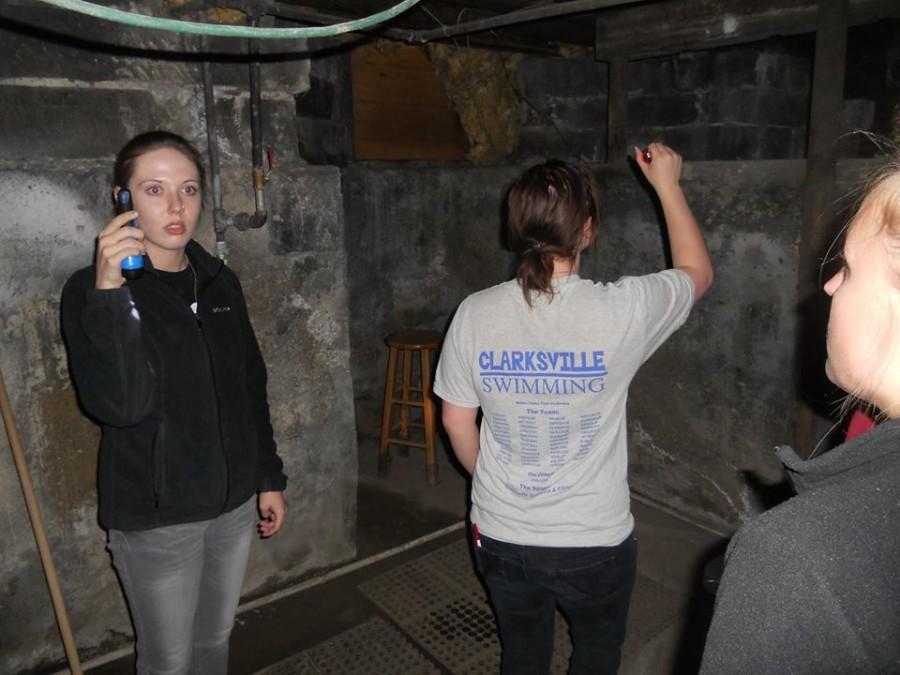Let Me Lobby For My Hobby: Paranormal Research
Katie Glesing, communications senior, (left) has spent the last two years doing paranormal research.
March 10, 2015
Measuring for electronic voice phenomenon, studying the effects of geomagnetic fields and researching how our ideas can influence what we perceive are all part of the job when you’re a paranormal researcher. This is the hobby that Katie Glesing, communications senior, has spent the last two years doing.
“You get a lot of skeptics and a lot of people who are firm believers,” Glesing said. ‘So it’s really hard to weed out the crazy there. When you get a group of people who are students and academics who are dedicated to doing real research on this, from the standpoint of, ‘It’s not real, it’s not fake, but look at what we’ve got.’ That’s what our point is.”
Glesing started her paranormal research in 2013 when she signed up for a para-psychology class that was offered at IU Southeast.
“We traveled the whole East Coast and actually learned how to collect research data in psychology,” Glesing said. “It’s usually really unbiased material, since we’re doing it according to the scientific method, using everything that we were taught as students in that classroom.”
With the class, Glesing was able to travel to some of the biggest haunted locations in the United States.
“We went to Bobby Mackey’s (Wilder, Ky.), Waverly (Louisville), East Bay Inn (Savannah, Ga.) and Myrtle’s Plantation (St. Francisville, La.), which is supposedly the most haunted plantation in the United States.”
Since the class ended Glesing said that she has continued her paranormal research with the only academic paranormal research group that is actively publishing to research journals, The Institute for the Study of Religious and Anomalous Experiences, or ISRAE for short.
“ISRAE was just founded, but they have been operating as the research branch, The Association for the Study of Anomalous Field Phenomenon,” Glesing said. “That’s the group that goes out and does the research and logs the data and makes sure when something happens, nothing else caused it, to make sure it’s purely anomalous.”
In her research with the ISRAE, Glesing has had a few run-ins with anomalous events. A half-way deflated beach ball that moved, seemingly on its own, off of a headboard and towards Glesing and another member during an investigation.
“I said, ‘If there’s anything in this room, can you make something move?’ And we had this half-way deflated beach ball, which, it is not the best research tool, but we had it on a headboard at the foot of the bed, and we we’re sitting on the bed,” Glesing said. “We we’re sitting away from the headboard just to make sure we didn’t contaminate it, we’ve got two video cameras on it, and I ask that question and the ball falls. The ball falls towards me. So if I would have kicked it, it would have fallen forward, but it fell backward and then on to the floor.”
She called to the head of the group, and they ran a few tests on the ball to make sure it was not human error.
“We put the ball back, and we blew on it and did all of these tests on camera, so you can tell that there is no way in heck that we influenced the ball falling.”
After they ran the tests and the group leader left, Glesing calmed herself down to resume testing. She asked the question again, and an old doll across the room started making noise.
“None of them are motion activated. They’re all push activated and kind of older, so you actually have to put effort into pushing on them,” she said. “One started giggling, and we just didn’t know what to do.”
While the institute does research hauntings, Glesing said that they do not limit themselves to only researching haunted locations. They’ve also done research on the psychology in how people perceive the paranormal.
“I did a seance here at IUS with a couple people from the group,” she said. “While you’re doing it, it’s kind of scary because you get a lot of the psychosomatic, ‘Oh, my stomach hurts.’ ‘Oh my stomach hurts too, that’s crazy!’ You get to find out what we’re doing to each other, versus what’s actually happening in the environment.”
Unlike the ghost hunting reality shows that you can find on TV, Glesing said the ISRAE adheres to the scientific method and keep its research unbiased.
“Everything we do, we can put out there,” she said. “We actually have three different journal publications that have made it into circulation.”
Glesing said what drew her to paranormal research was her natural curiosity and that she is drawn to the unknown.
“That’s the worst thing, not knowing. People are so set in their minds that science has solved everything, but there’s so much more that we haven’t even touched. People are discovering new stars, new galaxies, new matter all the time.”
For anyone interested in getting involved with the Institute for the Study of Religious and Anomalous Experiences, Glesing said that all people, even skeptics, are welcome to join the groups’ Friday night classes.
“Come to our talks and ask us questions! We’re open to everyone. It’s only $5, and you can have all the cookies and coffee you want!”
$5, Friday from 7 to 9:30 p.m. Social hour is from 7-8 p.m. Lecture is from 8-9 p.m., with Q&A afterwards. The Historic Grisamore House. 111 West Chestnut St. Jeffersonville.


